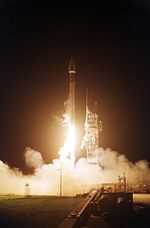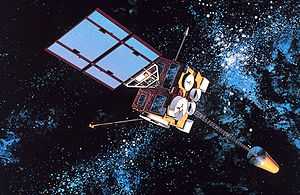GOES 12
 GOES-M during processing | |
| Mission type | Weather satellite |
|---|---|
| Operator | NOAA/NASA |
| COSPAR ID | 2001-031A |
| Mission duration |
5 years (planned) 12 years (achieved) |
| Spacecraft properties | |
| Bus | LS-1300 |
| Manufacturer | Space Systems/Loral |
| Launch mass | 2,279 kilograms (5,024 lb) |
| Start of mission | |
| Launch date | 23 July 2001, 07:23 UTC |
| Rocket | Atlas IIA |
| Launch site | Cape Canaveral SLC-36A |
| Contractor | ILS |
| End of mission | |
| Disposal | Decommissioned[1][2] |
| Deactivated | August 16, 2013, 13:00 UTC |
| Orbital parameters | |
| Reference system | Geocentric |
| Regime | Geostationary |
| Longitude |
90° West (2001-2003) 75° West (2003-2010) 60° West (2010-2013) |
| Slot |
GOES-EAST (2003-2010) GOES-SOUTH (2010-2013) |
GOES 12, known as GOES-M before becoming operational is an American weather satellite, which is part of the US National Oceanic and Atmospheric Administration's Geostationary Operational Environmental Satellite system. It was launched in 2001, and as of April 2010 it is in standby orbit.[3] Prior to standby, it was operating in the GOES-EAST position, providing coverage of the east coast of the United States.[4]
Launch

GOES-M was launched aboard an International Launch Services Atlas IIA rocket,[5] flying from Space Launch Complex 36A at the Cape Canaveral Air Force Station. The launch occurred at 07:23 GMT on 23 August,[6] having previously been delayed eight days; seven due to a faulty controller in the second stage of the carrier rocket, and one to ensure that a lightning strike at SLC-36B had not caused any damage to the rocket.[7] At launch, the satellite had a mass of 2,279 kilograms (5,024 lb), and an expected operational lifespan of five years, although it carried fuel for longer.[8] It was built by Space Systems/Loral, based on the LS-1300 satellite bus, and was the last of five GOES-I series satellites to be launched.
Operations
Following launch, it was positioned in geostationary orbit at a longitude of 90° West, where it underwent on-orbit testing, and was then stored until it was needed to replace an operational satellite. It served as an on-orbit spare until 2003, when it was called up to replace GOES 8, an older satellite which, while still operational, would have run out of fuel by the end of the year.[9] Although GOES 11 was the next backup in line for activation, GOES 12 was used instead in order to test its Solar X-ray Imager.[7] The Solar X-ray Imager failed in April 2006.
Thruster problems
| Wikinews has related news: GOES-12 weather satellite fails during adjustment |
Since December 2007, GOES 12 has experienced three thruster leaks during orbital adjustment manoeuvres, two of which led to major outages. The first of these occurred in December 2007, during an annual manoeuvre to reduce the inclination of the satellite's orbit. The faulty thruster was shut down, and the satellite was returned to its station by means of what was thought at the time to be a backup thruster. It was later discovered that the primary and backup thrusters had been wired the wrong way around, so it had actually switched from the backup system to the primary system, however this was believed to be unrelated to the failure.[7] During this outage, GOES 10, a retired satellite which had been kept in orbit to provide coverage of South America, was briefly returned to service to cover for GOES 12.[10]
Another outage occurred on 14 December 2008, when an inactive thruster leaked, sending the satellite out of control. The on-orbit-spare satellite, GOES 13, was brought online in case GOES 12 had to be replaced, and took over imagery from its storage location at 105° West whilst the fault was investigated. The problem cleared several weeks later, and the satellite was returned to operational status on 5 January 2009, with GOES 13 being returned to on-orbit storage.[10]
Since then, several other leaks have occurred, however none has impacted operations.[11] During a leak in May 2009, the GOES 13 satellite was again activated, however it did not need to take over operations. Because of the thruster problems, GOES 12 was replaced by GOES 13 in the GOES-EAST position. GOES 12 continues to be operational, but in standby.[3]
See also
References
- ↑ Status of GOES-12 (GOES-South America) Sounder and Imager;GOES-12 EMWIN Broadcast and GOES-Services (GOES-DCS, LRIT, SARSAT and EMWIN)
- ↑ GOES-12 status
- ↑ 3.0 3.1 "GOES Status". NOAA. 2010-04-14. Retrieved 2010-14-27. Check date values in:
|accessdate=(help) - ↑ "GOES-NEWS". NASA. 2009-05-09. Retrieved 2009-07-09.
- ↑ Wade, Mark. "FS 1300". Encyclopedia Astronautica. Retrieved 2009-07-09.
- ↑ McDowell, Jonathan. "Launch Log". Jonathan's Space Page. Retrieved 2009-07-09.
- ↑ 7.0 7.1 7.2 "GOES-12 Status". NOAA. Retrieved 2009-07-09.
- ↑ Krebs, Gunter. "GOES 8, 9, 10, 11, 12". Gunter's Space Page. Retrieved 2009-07-09.
- ↑ "GOES 8/12 Transition Plan". NASA. 2002-10-28. Retrieved 2009-07-09.
- ↑ 10.0 10.1 "GOES 12 [GOES-M]". Failures. Sat ND. Retrieved 2009-07-09.
- ↑ "CLASS News". NOAA. Retrieved 2009-07-09.
| ||||||||||||||||||||||||
| ||||||||||
